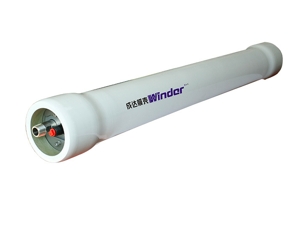FRP pressure vessel supplier introduces you: Reverse osmosis water treatment technology is a high-end water treatment technology emerging at the end of the 20th century. It has a high salt rejection rate, a wide range of water content and salt content, low chemical consumption, Small area, high degree of automation, stable water quality and other characteristics, widely used in ultra-pure water preparation, surface water treatment, industrial wastewater reuse, seawater desalination and other water treatment. This project is the first phase of the PDP project. The process is characterized by "high precision technology and high cleanliness". The water treatment process needs to provide electronic ultrapure water for production, and the reverse osmosis system is the most important desalination treatment system among them.
1 The situation of electronic ultrapure water and system water
Electronic ultrapure water refers to water that almost completely removes the conductive medium in water, and removes the non-dissociable colloidal substances, gases and organic matter in the water to a very low degree. In addition to water molecules (H2O), there are almost no impurities in the water. No bacteria, viruses, chlorine-containing dioxins and other organic substances. The water can be produced by distillation, deionization, reverse osmosis technology or other appropriate supercritical fine technology. Nowadays, it is mainly based on reverse osmosis technology. The manufacturing process is relatively common. This project also uses reverse osmosis technology as the main desalination process to prepare electronic ultrapure water. The raw water of this water treatment project is taken from municipal tap water. The electrical conductivity fluctuates between 200 and 800 μS / cm, and the residual chlorine concentration in the fluctuated water ranges between 0.2 and 1 mg / L.
FRP water softening is divided into a pretreatment system + a reverse osmosis-based desalination system + a fine processing system + (after heating) + a subsequent fine processing process, and finally electronic ultrapure water is obtained. The entire water treatment system has a heating function, and the inlet water temperature can be adjusted according to different water temperature needs. The pretreatment system consists of flocculants and bactericides + fully automatic multi-media filters + fully automatic activated carbon filters + pretreatment water tank + pretreatment delivery pump. Mainly by adding agents and mechanical filters to remove sediment, suspended solids, colloids, microorganisms and other substances in the water, to ensure that the SDI15 of the produced water is <5, and to meet the infiltration conditions of reverse osmosis. The reverse osmosis-based desalination system is mainly composed of a primary reverse osmosis system and a secondary reverse osmosis system, especially the primary reverse osmosis system, which is the main desalination system. It consists of heat exchanger + security filter + high-pressure pump + primary reverse osmosis system + buffer water tank + secondary high pressure pump + secondary reverse osmosis system + water tank. Since the reverse osmosis system allows a relatively wide range of salt content in the feedwater and a high desalination rate, it can play a major role in desalination and reduce the desalination load of subsequent processes. The precision treatment system is mainly composed of a water inlet pump + a TOC UV + membrane degassing system + a continuous electric desalination system (CEDI), which is mainly to further remove the salt content in the water and provide stable water quality guarantee for the subsequent precision treatment system. Subsequent fine processing is divided into two streams of water according to different distributions. It consists of water tank + pump + secondary TOC UV + ultra-pure water polishing mixed bed + heat exchanger + 0.1 μm filter. After that, water produced at different temperatures is used as ultra-pure water. The operation of the primary reverse osmosis system is mainly introduced. The water treatment system is mainly composed of multi-media filter + activated carbon filter + primary RO system + secondary RO system + CEDI system + PCW system (boiler make-up water) + [(25 ± 1) ℃ ultrapure water system + (40 ± 1) ℃ ultrapure water system].

Frp Water Softening
3 Design of reverse osmosis system
The reverse osmosis system is the core of desalination in the entire water treatment system. The DTRO shell for landfill leachate treatment can remove most of the soluble salts in the water and remove all the colloids and microorganisms in the water to ensure the effluent. Water quality, providing high-quality water for subsequent processes. Considering that the quality of raw water (municipal tap water) is highly volatile due to the influence of seasons and climate, the reverse osmosis membrane used in this water treatment system is a polyamide composite antifouling membrane PURO series produced by Time Wharton, compared with ordinary Membrane elements. This series of membrane elements use a special process to treat the membrane surface, which changes the smoothness of the membrane surface, increases the hydrophilicity of the membrane surface, and the charge on the membrane surface approaches neutral. At the same time, 34 mil (8.636 × 10-4 m) wide inlet flow channel network design, which reduces the pollution of colloids, pollutants and microorganisms on the membrane surface, prolongs the service life of the membrane, and is easier to clean. The specific membrane type is PURO-I, a 201 mm diameter roll module with a length of 1 016 mm
The single set of the first-stage reverse osmosis system is designed in two stages: (14: 6) × 6, a single set of 120 membrane elements, the system is designed to produce 103 mm3 / h of water, the designed recovery rate is 75%, and the temperature is 25 ℃. 5 sets of 600 membrane elements. A reverse osmosis membrane system is mainly introduced to explain the operation of the water system.